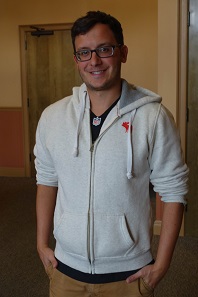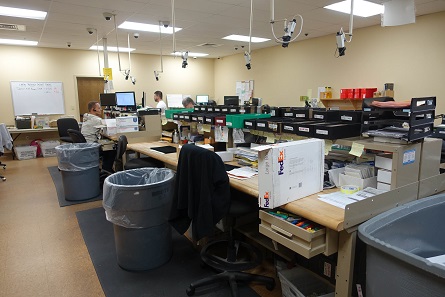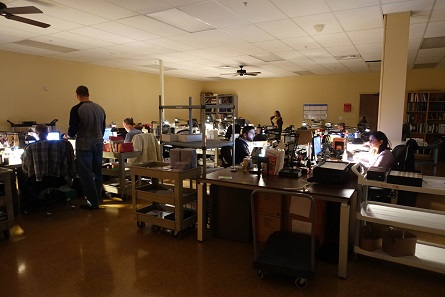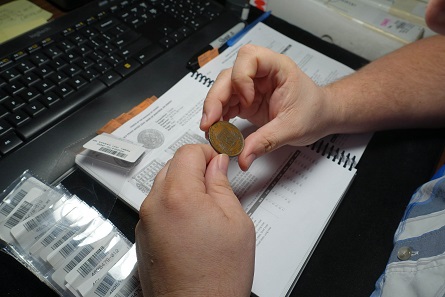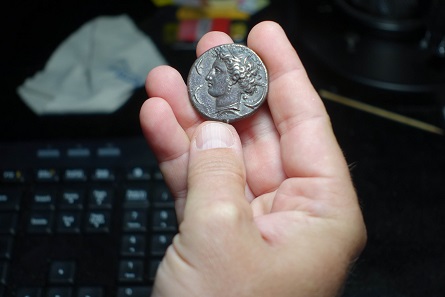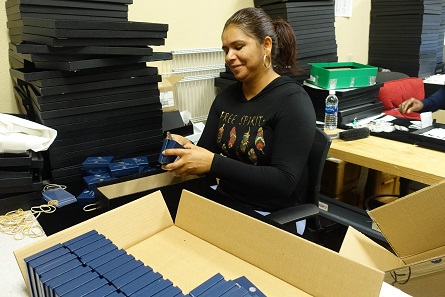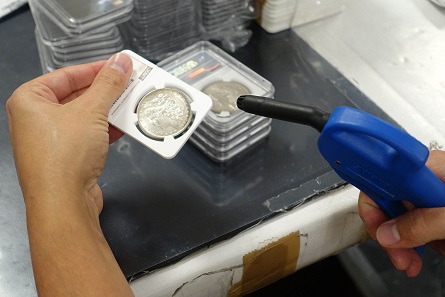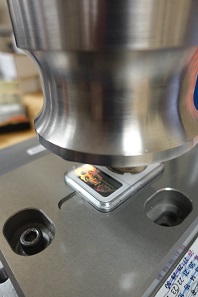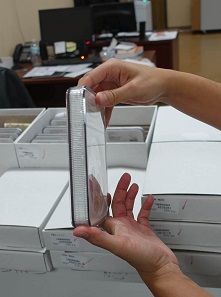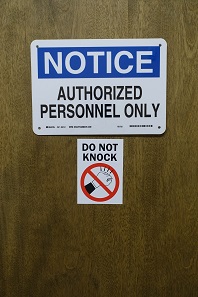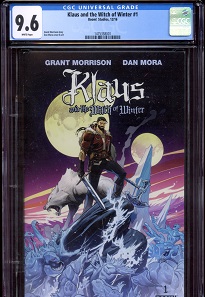by Ursula Kampmann
March 22, 2018 – Over the course of more than 30 years since its founding, NGC has by now examined, graded and slabbed more than 40 million coins. Millions of clients rely on this grading service. But what happens behind the scenes? Ursula Kampmann visited the headquarters in Sarasota, Florida.
The entry to the building which houses the entire Certified Collectibles Group. Photo: UK.
First off: The NGC building is huge and well-protected. To pass through the entry gate, you must be registered. Which is no surprise, given all the valuables that are stored here on a short-term basis. All items submitted to NGC for quality control either pass through this building or the Chinese branch. The only exceptions are cases where NGC sends their graders to a different location for some specific activity. Recently, such grading days were held during the Numismata in Munich. A tiring venture for the graders, who provided their service from early in the morning until late at night. The queue that built up at the NGC booth on Sunday afternoon, where people came to pick up their graded coins, was proof enough for anybody that grading has come to play an important role in Europe as well.
Paul Sandler accompanied me for a solid two hours during my look behind the scenes of NGC. Photo: UK.
But back to Sarasota. Not only NGC’s graders work at the headquarters. These days, the umbrella organization, CCG (Certified Collectibles Group), includes five internationally operating companies: NGC (Numismatic Guaranty Corporation) being responsible for coins, while PMG (Paper Money Guaranty) grades notes and CGC (Certified Guaranty Company) grades comics. The newest CCG branch is the only one based in China: ASG (Authenticated Stamp Guaranty), grading stamps, primarily targets the Asian market, but is expected to expand to other markets in a couple of years. Besides grading, CCG has specialized in another important activity: NCS (Numismatic Conservation Service) professionally cleans coins and prepares them for grading. CCS (Classic Collectible Services) professionally restores comic books.
The heart of the company: the logistics center. Photo: UK.
The heart of everything in Sarasota is the logistics center, where all coins arrive that have been sent to the European and American submission centers. Apart from NGC’s own centers in London and Munich, there are additional NGC-approved coin dealers functioning as agents. Especially in Asia, NGC is an established player. That’s why there are more submission centers there than in Europe. They are located in Hongkong, Japan, Singapore and South Korea. The coins submitted there usually don’t have to be sent to Sarasota but are graded at the Chinese branch.
A slightly old info clip mentions that coins can be submitted in a total of 43 nations. Today’s number is bound to be higher.
This is where the coins arrive. Photo: UK.
In the entrance area, it is made sure that each package contains what the accompanying leaflet says it does. Every package is unpacked under the watchful eye of a camera, and the contents are compared with the submission form. Next, each coin is put in a temporary holder receiving a barcode which will accompany the piece all the way to the exit. Thus, all the coins are anonymized. That is important so as to inhibit the temptation of giving favor reports.
Notice the differently labelled boxes in the entrance area. These are necessary because, already at logistics, it is decided which coin goes to which department. At NGC, there is no one all-rounder responsible for all coins; instead, for every single coin, there are several experts examining it.
The process of grading: In a darkened room, with a single, bright light source. Photo: UK.
It is not exactly idyllic at NGC. No lonely coin enthusiast sitting at a table. Instead, the experts are grouped in several large rooms. The atmosphere is calm, focused – hence the darkened room. But in case of doubt, it’s always possible to ask the neighbor.
What’s more, every grading is independently confirmed by a second expert, so that for every coin, not one, but two opinions are provided.
Naturally, there is also specialist literature to consult. Photo: UK.
NGC employs a total of about 30 graders. None of them deals in coins, so there is no personal interest in giving certain coins a better grade. Some of the experts have been working at NGC for more than 20 years! They know their area of expertise very well. Nonetheless, they know their own limits, too. On their website, NGC has published a long list of coins that are not eligible for grading. It includes for example German coins minted bevor 1600 AD. For Switzerland, the threshold is 1500 AD. For China, 1880 figures as the limit.
Even ancient coins can be graded. Photo: UK.
For a while now, NGC has been offering its grading service of ancient coins. Here as well, there are rules. Ancient cast coins are not eligible for grading, like for instance aes grave. Fragile pieces like Byzantine scyphates are not accepted because they could be damaged during slabbing.
Very problematic are altered coins. For, especially bronze coins, present in collections since the 19th century, were often smoothed, which makes them ineligible for NGC grading.
A controversial subject among opponents is the NGC policy of exclusively grading coins that their own experts consider “genuine” without a doubt. Questionable coins where opinions (may) diverge are returned (not encapsulated) to the submitter. That is not satisfactory for coin dealers who believe themselves to be the better experts on the subject. And they may well be right concerning the authenticity of a singular special case, but since NGC vouches for all their evaluations, they only want to certify coins their own experts are completely sure about. By the way, in (clarifiable) cases of doubt, third-party experts are in fact consulted. NGC has a list of freelance experts that they regularly contact.
In consultation: No decision is made by one expert alone. Photo: UK.
And what if, after grading, an external expert suspects a coin to be counterfeit, albeit NGC’s expertise? There is a clearly defined procedure for those cases. Most importantly, the item must remain in its holder. The expert has to explain in writing why he thinks the coin is suspicious. It is then sent back to NGC. They remove the coin from its holder and work together with different specialists in order to ascertain if the suspicion is justified or not. “Naturally, even we make mistakes”, Paul Sandler comments. “But, first of all, we take responsibility for it. And that’s why, second of all, we have our clearly defined procedure for clarifying if we really did make a mistake or not.”
By the way, the guarantee – for the coin’s authenticity as well as for not having been overgraded – is passed on to the new owner. If the new owner sees any problems, he ought to submit the encapsulated coin to NGC under the free Appearance Review service.
Max Spiegel adds to that: “Although some skeptics may think that we would not be fair in our review of an NGC-certified coin, this could not be farther from the truth. We have been in business for 31 years and it is in our best interest to be fair and only have accurately graded, genuine NGC-certified coins in the market. Every NGC-certified coin is a reflection of our company and the expertise of our graders – if we make a mistake, we want to correct it.
Our mistakes are thankfully rare, but with 40 million coins graded there are bound to be a handful. Our guarantee should provide comfort to any owner of an NGC-certified coin that if it is ever determined that we did make a mistake, we will make it right.”
A new phenomenon: More and more contemporary coins are submitted to NGC for grading. Photo: UK.
For a couple of years now, more and more recently minted coins are submitted for certification, in order to have their grade determined by experts and at the same time prevent changes of the items by encapsulating them in an NGC holder.
Proven minting quality of products from American mints. Photo: UK.
These days, recently minted coins score an even higher price if NGC confirms that they are in fact “Gem MS” – if possible with the highest numeric score of 70 – and not “just” “Choice Mint State”.
Notice the terminology: the term “mint state” (MS) used by NGC does in fact designate the grade of a recently minted coin. The term “proof”, used by mints and often seen in auction catalogues as a synonym for grade, is not actually the grade, but a particular minting technique for achieving a field with mirror finish through a special production procedure.
Before the final encapsulation, coin and holder are cleansed with pressurized air. Photo: UK.
Once the grading process is finished, NGC needs to make sure that the coin and its evaluation cannot be separated. The company has developed plastic holders that are extremely hard to break open. They are tested as not to damage the coin with any chemicals.
NGC is proud that the Smithsonian Institution, which houses the National Numismatic Collection in the National Museum of American History, comprising 1.6 million items, stores their most valuable coins in exactly those holders.
What’s more, each holder has a number of security features like the ones used for banknotes. Thus, NGC protects itself and its clients against counterfeits. In addition, each coin has its own unique number. Under this number, NGC stores images of the front and back of precisely this individual piece.
The holders are sealed under high pressure. Photo: UK.
How exactly the holders are sealed is a company secret. In any case, coins in an NGC holder cannot be switched out without it being visible.
Naturally, NGC is happy to present oversize items fitted into their special holders. Photo: UK.
Besides standard sizes, NGC has also developed holders for special sizes. They are quite spectacular.
Final check: Before being shipped, each coin is checked one last time to make sure that the final product meets NGC standards. Photo. UK.
But no matter if 1/10-oz or one-kilogram coin, if ancient tetradrachm, double eagle or Swiss taler, each slabbed coin is checked for quality one last time before shipping. Only then is it brought to the logistics center, from where it is – carefully packaged and insured – returned to the submitter.
The entry to the conservation center. Not even employees are permitted to enter. Photo: UK.
But of course, our tour did not end here. We passed by the conservation center, where NCS and CCS respectively make sure that coins present themselves at their best, and professionally repair comics with small defects.
We visited PMG where banknotes are graded. Photo: UK.
We also stopped at PMG, Paper Money Guaranty, where, since its founding in 2005, a total of 2.5 million banknotes have been graded and encapsulated.
Banknotes from all over the world are graded at PMG. Photo: UK.
PMG works with almost all banknotes from all over the world. In addition, test notes can be submitted for grading, as well as select satire and fantasy notes (Disney for example has been issuing its own money since 1987).
This is what a CGC-graded comic looks like. Photo: UK.
We paid a visit to CGC (Certified Guaranty Company) as well, where a team of comic aficionados grade more than 100,000 comics every year. I will never understand how they manage to grade all those comics without getting lost in the story.
The rules in Sarasota being quite strict, I was not allowed to take any pictures inside the comic center. My permission applied only to the coin and banknote areas …
This department is probably where it’s the most obvious why so many Europeans are fighting against the process of grading and slabbing. Europeans who collect comics do that because they love the colorful stories and passionately read the items of the 9th art, which is what “bandes dessinées” are referred to in France. But how to read a comic that has been encapsulated in heavy plastic?
Let’s look back to the beginning of slabbing. It was first introduced in order to guarantee the buyer that the grade indicated by the seller was in fact correct. After the purchase, every buyer could actually remove the holder and enjoy the included item however they please.
But, with more and more investors putting money into collectibles, the coins, banknotes and comics remain in the holder. Which is certainly not the fault of NGC, PMG or CGC.
For everyone is free to break the coins, banknotes and comics out of their holders after the purchase. On the contrary, all these companies would be happy to be able to grade and slab items not only once, but several times – each time before they are sold again.
NGC has a very extensive website.
Here you can find NGC’s numeric grading scale.
NGC regularly sends out eNews and weekly market reports.
NGC has a very active collectors society.
Here you can watch a video of a coin’s journey through NGC.
CoinWeek recently published videos that show how banknotes are graded at PMG.
Here is an overview about the grading of comics.






